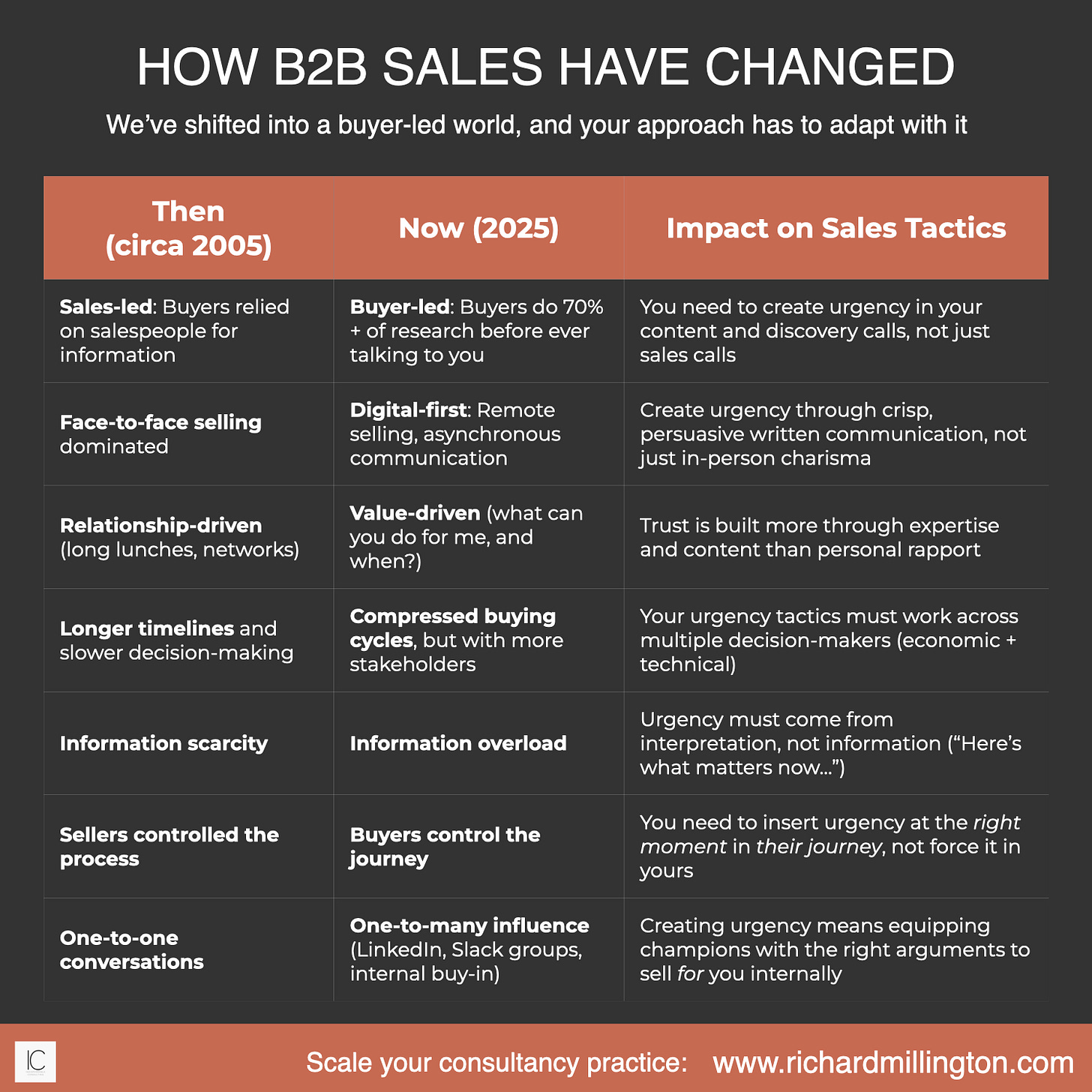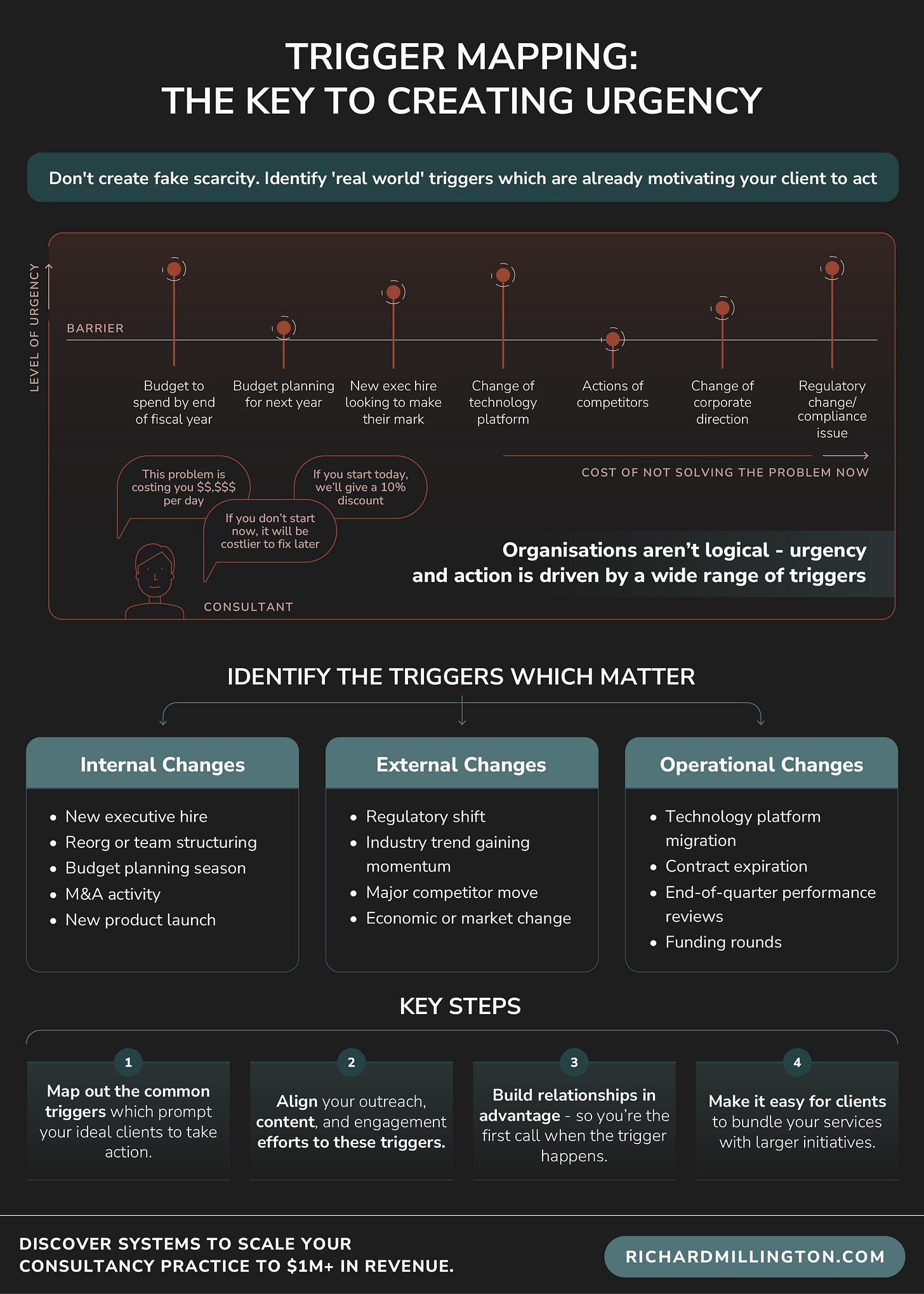Trigger Mapping: Identify What Motivates Clients To Act
It's common for organisations to delay investing in consulting projects. Why do it today when it can be done tomorrow? Embed your services into problems which are already urgent.
Hi, I’m Rich. Welcome to my weekly newsletter where I share systems and frameworks for scaling your consulting practice from $0 to $1m+ in revenue.
You can get 1:1 personal coaching or explore my new course: Proposal Mastery: Learn To Write Winning Business Proposals.
Why Strategy Projects Are Often Put On Hold
A problem with many consulting projects is that they’re anytime projects.
It’s a little like replacing your carpet.
Sure, you could do it tomorrow….or in a week, month, year, etc. There’s not much urgency in doing it today.
You know it’s a lot of work and you must do it sometime, so why not put it off?
I’d guesstimate around 50% of the inquiries we get are for anytime projects. This is especially true on the strategy side. Yes, they want to improve their [x], but there’s no apparent reason to do it today.
The problem with this is that ‘anytime’ projects are famously likely to be stalled, cancelled, or experience prolonged bouts of ‘too busy to work on this right now’ from your clients.
B2B Sales Have Changed A Lot In 20 Years
If you read sales books from 15 to 20 years ago, they will tell you you need to create a sense of urgency.
For example, you might:
Calculate how much this problem is costing the client per day.
Identify how much cheaper it is to fix it now rather than wait longer.
Create a special offer if they sign up right now.
But these tactics worked well in the ‘before time’ - when buyers needed (and trusted) sales professionals for information. These techniques are more likely to come across as patronising and self-serving sales dross.
This is because the nature of B2B sales has changed immensely over the past twenty years. You can see some of the most significant changes below:

In short, selling today depends less on schmoozing and saying the right thing ‘in the room’ and more on building time sensitivity into the service and the entire process.
This means that past techniques to create an artificial sense of urgency no longer work.
How We Used Existing Urgency To Attract Clients
Let me give you an example from FeverBee.
A big part of our business is selling community strategies. The problem is that strategies are famously anytime projects. They could be done today, tomorrow, or next year without any apparent changes in outcome (for the client).
Over the years, though, we’ve noticed something interesting. An organisation often asks for strategy support while considering (or has decided) to move its community to a different platform.
There are two reasons for this - both mirror the modern approach to selling.
Major technology changes are naturally a time to reassess and evaluate goals and methods, and ensure the organisation doesn’t make a big mistake. If they invest a large sum in a community platform, they want to get the most from their investment.
Approval for a strategy consultant is easier when bundled with a bigger cost. Getting internal approval on a $50k strategy project is much easier when bundling it with a $250k platform purchase. It often seems like a prudent thing to do to ensure the organisation is getting the most from its investment. Organisations tend to either approve or reject both. It also seems relatively cheap by comparison. It’s the equivalent of ‘Would you like fries with that?’
This doesn’t mean an organisation can’t look for a new strategy without a technology change; that often happens, too. But the key lesson is this:
An organisation doesn’t typically seek a new strategy without a significant trigger. That trigger might be a change in technology, goals, staff, or a major external event. The key is identifying the most common triggers and linking your service and engagement efforts to them.
This is where we have to understand trigger mapping.
What Is Trigger Mapping?
Trigger mapping is the process of identifying and aligning your services or outreach efforts with specific events, conditions, or changes that naturally cause a client to take action.
Think of it as answering the question:
“What usually happens right before someone needs what I offer?”
Examples of Common Triggers:
Internal changes
New executive hire
Reorg or team restructuring
Budget planning season
M&A activity
New product launch
External changes
Regulatory shift
Industry trend gaining momentum
Major competitor move
Economic or market change
Operational changes
Technology platform migration
Contract expiration
End-of-quarter performance reviews
Funding rounds
Why Trigger Mapping Matters
It’s very hard to create a sense of urgency today. But you can look for moments within the environment that suddenly make the problem feel urgent.
Trigger mapping helps you time your outreach, personalise your approach, and, most importantly, position your offer as the next natural step.
The three biggest triggers of strategy projects in my experience are.
Change of technology platform. As per above.
Change of staff - i.e. a new senior person looking to make their mark.
Budgets (either the org has the budget to spend by a fixed date or is planning its budget for the following year).
This has some immediate implications for when you engage with clients. Don’t make it creepy, but it helps to know what the organisation is planning its budget for the next fiscal year, when its platform contracts expire or if a past client takes on a new role.
How to Use Trigger Mapping
Trigger mapping is generally pretty easy to do:
List your past successful clients.
What was happening just before they contacted you? (If you don’t have past clients, then ask people in your research calls what triggered them to buy services like yours in the past?)Look for patterns.
Do the same types of events keep showing up?Build your tactics around these triggers. Connect your content, relationship-building efforts, and marketing campaigns to these triggers.
Let’s go deeper into point 3 above. In our case, this might include:
Connect and build relationships with the major vendors in our space. They’re often the first to hear when an organisation considers a platform migration. Being part of that ecosystem makes us more likely to be introduced at the right time, when urgency already exists.
Monitor job changes. When a new Head of Community or Director of CX joins a company, they often want to make their mark early. These moments create natural windows for strategic work. We can monitor leadership changes and reach out within the first 60 days. This works exceptionally well for past clients with whom we have a good relationship. Get people in your alliance to reach out to.
Align messaging with industry events or broader changes. If new regulations are announced, if a competitor launches something impressive, or if budgets are about to reset, we can tailor our outreach accordingly. Timing matters more than persuasion.
What This Means For You
Rather than relying on persuasive tricks to create urgency, embed your work within real-world triggers that already motivate your clients to act.
Instead of trying to create urgency, you identify when urgency already exists and position your service to meet that need. This approach is smarter, more respectful, and far more effective.
This shifts the question from “How do I convince them to move forward?” to “When does this kind of work naturally become urgent?” and then positions you to show up exactly then.
That’s how you turn an ‘anytime’ project into a ‘right now’ project - without ever needing to push.
If you’re working on ‘anytime’ projects—especially in consulting, strategy, or other B2B services—stop trying to force urgency where it doesn’t exist. Instead:
Map out the common triggers that prompt your ideal clients to take action.
Align your outreach, content, and engagement with these trigger moments.
Build relationships in advance so you’re the first call when the trigger happens.
Make it easy for clients to bundle your services with larger, time-sensitive initiatives.
Good luck!
Connect with Rich
Are you new to the newsletter? Subscribe for free
Follow me on LinkedIn for more insights
Learn to write persuasive business proposals with my Proposal Mastery course.
Get 1 to 1 personal coaching. Get a personal coach to help you grow your consultancy practice. Tackle topics like positioning, client acquisition, delivering exceptional value, industry leaderships, and building the systems to thrive. Hit reply or learn more about my coaching approach.


